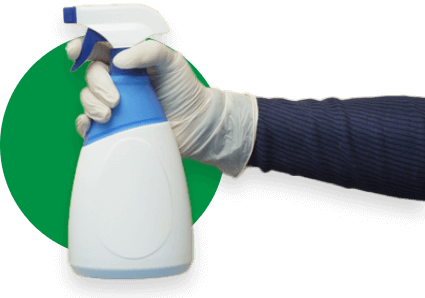In any office, appearances matter beyond the standard client visit. From the front desk to the corner chair, office furniture says something about your business. Dingy chairs and dusty desks can give the impression of disorganization, poor hygiene, and neglect. Worse still, they can impact your team’s health and morale.
In Dallas-Fort Worth, where offices are as diverse as the businesses they house, cleanliness isn’t just a matter of pride; it’s a competitive advantage.
Keeping your furniture clean is essential, but it can be a challenge if the task falls outside your comfort zone. At Dallas Janitorial Services, we’re here to break down how to clean office furniture like a pro, with clear, practical office furniture cleaning tips that go beyond a quick wipe.
Ready to transform your workspace? Discover how our professional office furniture cleaning tips can make a real difference, starting now!
Why Clean Office Furniture Matters More Than You Think
Most people don’t think twice about that coffee-stained chair or dusty conference table. But office furniture takes a beating every day. It collects dead skin, oils, allergens, food particles, and bacteria. All of which quietly lurk until someone sneezes or scratches their throat.
First impressions count. Whether it’s a potential client, a visiting executive, or your staff, a clean office conveys competence and fosters a sense of safety. Keeping your furniture clean is also a wise investment. Proper care extends the life of your furniture, reducing the need for premature replacements. And if you’re concerned about the causes of Sick Building Syndrome, unclean furniture may be a hidden contributor.
How to Clean Office Furniture With A Professional Approach
Before you grab the nearest spray bottle, let’s talk strategy. Professional office cleaning isn’t about doing more; it’s about doing it right.
We recommend breaking furniture care into daily, weekly, and monthly routines.
Daily
High-Touch Surfaces:
- Desks and Workstations – All surfaces on individual desks, including the desktop, keyboard, mouse, and telephone, should be wiped down regularly. This practice is essential for hot-desking environments where multiple individuals may use the same workstation throughout the day.
- Chair Arms – The armrests of office chairs accumulate a significant amount of dirt and germs from constant contact. Disinfect them thoroughly.
- Breakroom Tables and Counters – These communal eating and gathering areas are prime locations for the transmission of germs. All tables, countertops, and frequently touched appliances (such as microwave handles and refrigerator doors) in break rooms require regular cleaning and sanitizing.
Shared Conference Spaces:
- Conference Tables – After each meeting, sanitize conference tables to remove any lingering germs from participants.
- Chair Surfaces – Wipe down the backs and seats of chairs in conference rooms.
- Presentation Equipment – Clean remote controls, whiteboards, markers, and any shared technology or presentation tools after use.
- Door Handles and Light Switches – These high-touch points are common in any shared space and require consistent disinfection.
Weekly
Workstations:
- Dusting – Weekly dusting keeps your workstations clean, appealing, and healthy. Focus on desks, monitors, keyboards, mice, and any shelves or storage units. Don’t forget to tackle corners where dust can accumulate and remain hidden.
- Spot-Cleaning – Address any visible smudges, spills, or dirt on desks and other work surfaces with an EPA-approved disinfectant.
- Sanitization – Wipe down high-touch areas, such as keyboard keys, mice, and phone receivers, with a disinfectant wipe to reduce the spread of germs.
Chairs:
- Remove visible stains and dirt with a damp cloth and mild upholstery cleaner to remove the grime. Spot clean affected surfaces and avoid saturating the fabric.
Meeting Rooms:
- Sanitization – Disinfect all frequently touched surfaces, including conference tables, chair armrests, light switches, door handles, and presentation equipment (e.g., remote controls, whiteboards).
- Tidying – Straighten chairs, organize any stray papers or items, and ensure the room is generally neat and ready for subsequent use.
Monthly
- Upholstery – Use a steam cleaner or an appropriate upholstery cleaning machine to thoroughly clean all upholstered furniture, including sofas, chairs, and ottomans. Proper sanitizing of office furniture is a key part of this monthly deep clean. Pay close attention to high-traffic areas and any visible stains. Allow ample time for the upholstery to dry completely to prevent mildew.
- Leather Conditioning – For all leather furniture, apply a high-quality leather conditioner. This will help to moisturize the leather, prevent cracking, and maintain its supple texture. Always follow the manufacturer’s instructions for application.
- Under Furniture Vacuuming – Move all movable furniture (such as sofas, chairs, tables, and beds) to access and thoroughly vacuum the floor underneath. This will remove accumulated dust bunnies, pet hair, and debris that regular vacuuming might miss. Use appropriate attachments to reach tight corners and crevices.
Professional crews like ours use microfiber cloths, HEPA vacuums, EPA-registered disinfectants, and steam cleaners. Meanwhile, many DIY attempts rely on all-purpose cleaners and guesswork, which can be an easy way to damage furniture or leave behind grime.
Also, remember: cleaning removes dirt. Disinfecting kills germs. You need both. Our guide on basic disinfection protocols explains when and where each step matters.
How to Clean Office Desks, Tables & Shared Surfaces
Learning how to clean office furniture begins with the most frequently used surfaces. Let’s tackle how to clean an office desk effectively. Desks are a magnet for clutter, crumbs, and fingerprints, especially when people eat lunch at their workstation. To properly clean an office desk, you must consider its material. Cleaning them well keeps germs at bay and helps electronics last longer.
Laminate Surfaces
When laminate surfaces are at stake, always use a soft, lint-free cloth for cleaning. Always opt for a gentle, pH-neutral formula. Avoid products that contain ammonia. This harsh chemical can cause irreversible damage, such as discoloration, fading, and premature furniture degradation.
Wood Desks
Using a part water, part wood cleaning solution, take a lint-free cloth and prep for cleaning. Dampen the cloth, as oversaturation can damage the wood. After cleaning, wipe down the surface with a dry cloth to maintain the wood’s integrity.
Metal Tables
Metal tables require effective cleaning with a microfiber cloth paired with a solution of diluted dish soap. Using this cleaning combo effectively removes dirt and grime without scratching metal surfaces. After cleaning, dry the metal surface as lingering moisture can lead to rust.
Cleaning Around Electronics
Spray cleaner on your cloth, not directly on keyboards or monitors. For those tight spaces, like in between keys on a keyboard, compressed air can help dislodge debris that doesn’t want to let go.
Don’t forget to clean under items like mice, monitors, and desk organizers, all of which collect dust too.
Cleaning Office Chairs Without Damaging Them
Not all chairs are created equal, and neither are their cleaning needs. Knowing how to clean office furniture, such as chairs, depends heavily on the material. Here’s how to treat each type without exacerbating the issue.
Cleaning Fabric Office Chairs
Fabric chairs tend to attract dust, sweat, and crumbs from snacks.
- Vacuum first using an upholstery attachment to remove surface debris.
- Spot clean stains with a mix of warm water and a small amount of dish soap. We suggest testing the solution in a hidden area first to ensure it won’t stain or fade your fabric.
- Deep clean with a fabric cleaner or steam cleaner once a month or every few months, depending on use.
Avoid soaking the fabric; excess moisture can lead to mold or water stains. If you’re unsure how to clean office furniture upholstery, it’s best to call Dallas Janitorial Services for an expert cleaning.
Cleaning Mesh Office Chairs
Mesh chairs are breathable but prone to dust, hair, and oil build-up.
- Dust gently with a microfiber cloth or handheld vacuum.
- Armrests and seat edges collect oils from skin and lotions. Use a diluted disinfectant wipe and avoid scrubbing, which can damage the mesh.
- Don’t use hot water or harsh chemicals. This practice will cause the mesh to warp over time.
Cleaning Leather Office Chairs
Leather chairs scream “executive,” until they crack or peel.
- Wipe leather office chairs down weekly with a soft cloth and mild leather-safe cleaner.
- Condition the leather monthly to keep it supple and prevent drying.
- Avoid alcohol-based products, which cause fading and cracking.
Buff with a dry cloth after cleaning to restore the smooth finish.
Tackling Odors and Deep Stains Like a Pro
Sometimes the problem isn’t what you see, it’s what you smell. A key part of learning how to clean office furniture is addressing invisible issues, such as odors. Funky odors can seep into porous materials, such as upholstery, and even linger on plastic surfaces.
If you have bad smells in your office, here are some of the common culprits:
- Spilled food or drinks
- Body oils
- Mildew from poor ventilation
- Old cleaning product residue
Enzyme-based cleaners quickly tackle bad smells by breaking down organic compounds at their source. Your goal should be to eliminate scents at the source rather than masking smells. We have additional information on how to eliminate tips to get rid of office odors in our dedicated guide.
For deeper issues, professional disinfecting services make a real difference. If chairs still smell after a thorough scrub, it may be time for a steam or ozone treatment.
Specialty Areas – Breakrooms, Lobbies, and Outdoor Furniture
Every office has “forgotten zones.” These areas often fall through the cracks, leaving your office looking and smelling less than excellent.
Breakroom Furniture
Tables, plastic chairs, and microwave handles are breeding grounds for bacteria. Use food-safe cleaners daily and clean underneath surfaces every week.
Lobby and Reception Areas
These spaces set the tone for visitors. Use upholstery-safe cleaners for soft seating. Wipe down tables, sanitize the arms of chairs, and vacuum under furniture to keep them feeling and smelling fresh.
Outdoor Furniture
In DFW, patio furniture faces heat, dust, and sudden storms. Use a commercial outdoor furniture cleaner for metal or treated wood. Rinse thoroughly and let dry in the shade to avoid fading or water spots.
Also, inspect for spiderwebs or wasp nests if your team enjoys lunch outside. No one wants a surprise guest.
Should You DIY or Call the Pros?
Daily maintenance for your furniture can make DIY cleaning an appealing option, but it has its limitations. It can quickly become time-consuming for your staff, taking them away from their daily duties, for which you pay them. This is one of the main reasons for outsourcing office cleaning. When deciding how to clean office furniture, weighing these pros and cons is essential.
You also run the risk of improper product use and a lack of specialized tools, which can create liability if damage occurs.
A professional office cleaning service, on the other hand, offers expert handling of delicate materials and deep-cleaning solutions that you can’t find off the shelf. Our team doesn’t just clean; we notice things others miss. From mold under a chair cushion to forgotten stains in a waiting room, we’re trained to spot the small stuff before it becomes a big deal.
Accomplish Commercial Furniture Cleaning Without the Stress with Dallas Janitorial Services
Furniture is an investment, and one of the most overlooked parts of your workspace.
Following these office furniture cleaning tips supports health, morale, and your brand’s professional image. It reduces sick days, supports sanitization, and even helps eliminate odors you didn’t realize were lingering.
At Dallas Janitorial Services, we make cleaning office furniture simple. We’re fast, thorough, and easy to work with. With us on your side, you can rest easier knowing you have a consistently clean and healthy workspace.
For a truly pristine and healthy work environment, let the experts take care of it. Contact us today for a free quote on office furniture cleaning solutions tailored to your business!
Commercial Furniture Cleaning FAQs
What is the best thing to clean an office desk with?
Use a microfiber cloth and a mild, non-abrasive cleaner. Avoid ammonia-based products on wood or laminate, and always spray the fabric, not the surface directly.
How to deep clean a fabric office chair?
Vacuum first. Then, use a fabric cleaner or mild soap and water to remove stains. Let the chair air dry completely. Steam cleaning helps with deep sanitization.
How to clean an office chair that stinks?
Use an enzyme-based odor remover. If the smell persists, consider steam cleaning the upholstery or hiring a professional. Don’t just spray air freshener; it won’t remove the source.







